Name NOAAS Ronald H. Brown Laid down February 1995 Status Active NOAA fleet Construction started February 1995 | Operator NOAA Completed May 30, 1996 Length 84 m Launched 30 May 1996 | |
 | ||
Homeport Charleston, South Carolina Builders Vt Halter Marine Inc, Pascagoula | ||
NOAAS Ronald H. Brown (R 104) is a blue-water research vessel of the U.S. National Oceanic and Atmospheric Administration, she is NOAA's only Global Class research ship. She was launched on May 30, 1996 at Halter Marine's Moss Point shipyard in Pascagoula (the keel being laid in February 1995) and then commissioned on July 19, 1997 in Charleston. She was NOAA's first newly built oceanographic research vessel in 17 years.
The Brown is named for former Secretary of Commerce Ron Brown, who was killed in a plane crash on April 3, 1996, while on a trade mission to Bosnia, while in office. At 274 feet (84 m) in length, she is the largest vessel in the NOAA fleet. The hull of the ship is hardened against ice to allow for Arctic and Antarctic research. The ship has a total of 59 bunk spaces and can seat 30 at a time in her mess room. The ship also includes a 2-bed hospital facility. She carries a complement of six NOAA Corps commissioned officers, one commissioned U.S. Public Health Service medical officer, 22 crew and a maximum of 31 scientists.
The deck equipment features three winches, two fixed cranes, a portable crane, a hydrographic boom and an A-frame. This equipment gives the Ronald H. Brown a lifting capacity of up to 42,000 pounds (19,000 kg) as well as up to 10,000 metres (33,000 ft) of cable that can pull up to 8,100 pounds (3,700 kg). One of the winches is specifically for use with specialty cables such as optical fiber cables or coaxial EM Cable.
As a research vessel, a substantial amount of the ship is dedicated to laboratories. Included in the 4,100 square feet (380 m2) of lab space are a computer/electronics lab, a biochemical lab and a wet lab.
In addition to her state-of-the-art oceanographic sampling capabilities, the Ronald H. Brown has instrumentation to study the atmosphere, including a Doppler weather radar for a better understanding of storm dynamics at sea. This combined atmospheric and oceanographic sampling capability makes the ship unique in the world's research fleet. Scientists aboard the vessel study critical environmental issues across the world's oceans. She has participated in many national and international projects since 1997.
The Ronald H. Brown and three other research ships were all built to the same basic design. The three sister ships are R/V Thomas G. Thompson (UW), R/V Roger Revelle (Scripps) and R/V Atlantis (Woods Hole).
